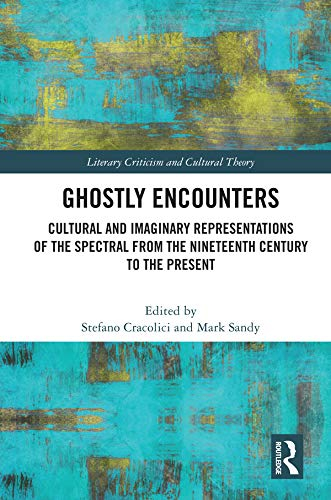
Reviewed by Tim Prasil
I suspect most readers of Ghostly Encounters will take it off the shelf of a university library and focus on just one slice of what it offers. After all, the collection’s nine essays, written by academics and published by Routledge, approach “the spectral” from very different directions and with different definitions. The essays range from Algernon Blackwood’s short story “Chemical” to Japanese painting and from Guillermo del Toro’s film Crimson Peak to the politico-aesthetics of Italian futurism. In addition, the volume is a bit pricey for many private bookshelves, the paperback, for instance, approaching ₤40 in the UK and $50 in the US. Nonetheless, reading the volume from cover to cover, I found myself pleasantly introduced to several topics in which I didn’t know I was interested.
A good example is Rosina Buckland’s “The Visual Representations of Ghosts in Early Modern Japan.” The piece is accessible to a non-specialist, and before reviewing several eighteenth- and nineteenth-century paintings, Buckland offers intriguing insights into Japanese cosmology. “After death,” she writes, “the soul begins its existence as a restless spirit (aramitama) and rituals of purification and appeasement are required by those left behind at set points from the point of death onwards” (p. 53). Certainly beliefs about restless spirits and about how to assist them are widespread, but it’s fascinating to see them practiced as a customary, if not commonplace, way of honoring the departed. While most of the essays deal with artistic subjects, Douglas J. Davies’ “Embodied Shadows: Sculpted Memory, Sensed Presence, and the Third Party” is more anthropological. He also nicely introduces readers to the focus: the history of—and recent questionnaires investigating—the sense of being in the presence of someone who has died. This essay, along with the book overall, reminds us that “ghosts” manifest in a variety of ways.
As should be expected, not all of the essays are quite as accessible to non-specialists as others. My personal familiarity with English and American ghost stories prepared me for Mike Pincombe’s analysis of the Blackwood short story and Ann Davies’ study of del Toro’s film, but both also encouraged me to revisit those works with the essayists’ enlightening ideas in mind. Perhaps I wrestled most with Christopher Lloyd’s “Ghosts in the City: From Baudelaire to Lydie Salvayre and Hilary Mantel.” No doubt, readers who have spent more time with these authors will better grasp how the nineteenth-century poet’s images of urban specters “converge and diverge” with the suburban ones of the two novelists of the twentieth and twenty-first centuries (p. 121).
But these varied responses are a reflection of the reviewer, not of the book. As I say, this kind of academic volume is largely intended to be read selectively, readers choosing the topics that already haunt them. Even so, it might shine a light down dark hallways never before explored.

